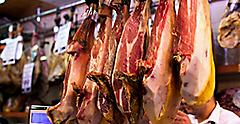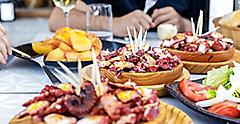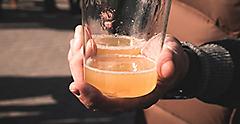The Most Popular Foods To Try When Visiting Spain
By Cassie Bailey | Published on November 13, 2025
Explore Spain’s Sun-Drenched Cuisine — Come Hungry!
In Europe, Spain has the second-largest area of land dedicated to agriculture. And yet, the land is notoriously difficult to cultivate. Around half of Spanish land can be used for agriculture. Maybe someone forgot to mention that to the headstrong Spanish farmers who continue to produce fabulous quantities of the world's finest oranges, olives and hams — which are, incidentally, among the most popular foods in Spain.
When traveling through Spain, expect to see golden fields of barley and wheat, streets lined with sweet-smelling orange trees and breweries overflowing with excellent wines and ciders. Let’s taste our way through the most popular foods in Spain, and see why there's so much fuss about olives!
Quick Takeaways: Must-Try Spanish Cuisine in Spain
- ● Spanish oranges: There are over 600 varieties of Spanish oranges to try, including sweet and sour.
- ● Jamón ibérico: A deep red marbled Spanish ham with fine white fat.
- ● Spanish cider: Spanish cider is amber, cloudy, quite dry and uncarbonated.
- ● Black and green olives: It’s common to eat olives as tapas, and more than half the world’s olive oil comes from Spanish orchards.
- ● The seafood: Spain has delectable local lobsters, clams, prawns and octopus. Spanish paella is a popular seafood dish in Spain.
- ● Spanish wine: Especially Vilafranca del Penedès, producing premium Spanish red, white and sparkling wines.
- ● Explore our cruises to Barcelona to taste your way through the Spanish Mediterranean and beyond.
Why Farmland In Spain Is So Special
Spain has surprisingly bad soil. Only 10% of it is considered "excellent" for cultivation by experts. With a Mediterranean climate and a mountainous terrain, farming isn't an easy undertaking. Spanish farmers still wake up every day and make magic happen.
Farmland in Spain is divided into massive estates (100-plus hectares) and much smaller "micro" farms. Thanks to the farmers' skills and irrigation technology, Spain produces the most olives and olive oil in the world. It’s also Western Europe's top producer of citrus fruits and has the largest area of vineyards in the world.
While the big estates account for over half of Spain's produce, the smaller farms are beginning to focus more intensely on organic farming, which allows them to cut costs on pesticides while increasing their profits — a win-win for everyone.
Here are six of the most fabulous and popular foods in Spain:
1. The Juiciest Oranges You've Ever Had

In summer, mountains of golden-hued orbs populate market stalls and grocery aisles. Oranges are Spain's cheapest foodie treasure at less than a euro each. But here's the thing — in Spain, an orange is not simply an orange. There are over 35 commercial varieties floating around.
Sweet Oranges
These are the most commonly eaten oranges. They are sweet, juicy and perfect to enjoy on a summer day. They are used for fruit juices, salads, desserts and plain snacking. Try red blood oranges, seedless navel oranges, Berna oranges or juicy Roble oranges.
Sour Oranges
Sour oranges are grown primarily for cooking, marmalades, marinades and essential oils. The best place to find them is Sevvarietyere, where they grow a variety called narajna amarga (nicknamed the Seville orange). It was originally grown as a decorative orange, thanks to its striking color. Local Sevillians turn it into a delectable marmalade.
Where To Find the Best Oranges in Spain
To find the best oranges in Spain, head to Valencia (nicknamed The Orchard of Spain), where the air is sweet with a gentle aroma of orange blossoms and roads are lined with fruit-laden trees. Or go to Seville, home to over 40,000 trees in the city alone!
How To Eat Spanish Oranges
The best way to enjoy oranges is to head to the local market, pick up a freshly picked bunch in a net bag and tuck it in. They're also sold in tarts, salads or fresh orange juice. A favorite dessert is oranges soaked in orange liqueur over vanilla ice cream. Mmmmm!
2. Ham (Jamón Ibérico): It's a National Obsession

Don't think of the over-processed, salty pink slabs you slap on a sandwich back home. Spanish ham is simply gorgeous. A deep red, marbled with fine white fat, jamón is made from "ibérico" (Iberian) pigs and is on par with the best artisanal ham in the world.
Jamón ibérico is made from the shoulders and hind leg of Iberian pigs (a hybrid of Spanish wild boars and domestic pigs). To make the ham, the pork is first preserved with sea salt for two weeks, then washed and hung for around a month. The ham is moved to a secadero (drying room) for drying. As the fat melts into the muscle, the flavor slowly intensifies over the next seven months. After aging is complete, the jamón is left to settle for two months before being packaged and released for sale. The whole curing process takes between 14 and 36 months, depending on the producer.
There are different grades of jamón depending on the breed of the pig and its diet. Purebred Iberian pigs fed on a free-range diet of only acorns produce the most expensive jamón, which is complex in flavor. The grade of jamón is color-coded, with black being the real deal, red being 50% Iberian, 50% acorn-fed, and white at least 50% Iberian with no dietary requirement.
3. Spanish Cider: Spain's Most Underappreciated Craft
Cider production in Spain can be traced all the way back to Roman settlers. It's unclear when apples were first introduced to Spain, but they are a major player in Spanish agriculture in modern times. Spanish cider is not what you expect. It's amber in color, cloudy, quite dry and not carbonated.
Apples are harvested from September to October and fermented for just six months in barrels. Nothing extra gets added — no yeast (it uses the natural yeast from apples), no sugar, just pure apple goodness.
The real event is when Spanish cider is poured into your glass. Traditionally, the liquid should be poured from a great height and only allow for one or two gulps per pour. The last sip is mostly sediment and is either discarded on the floor or — more commonly in modern times — into a bucket.
4. World Famous Olives
Spain is obsessed with olives. They have loved them longer than most places and put them in almost every dish. Olives came to Spain some 3,000 years ago (along with grapes) and were planted in Andalusia near the port cities of Malaga and Cadiz. Today, more than half of the world's olive oil originates from the orchards of Spain — some of which grow in the Spanish desert. Just like oranges, there are plenty of varieties of olives to try. Some are good for eating, and others are better suited to olive oil.
Green Table Olives
Table olives usually have a good ratio of flesh to pit and are relatively juicy. Manzanilla olives are the most popular and widespread table olives in Spain. They are fleshy and mild in flavor, making them the perfect entry-level olive for those unused to olive flavors.
On the other hand, Hojiblanca olives have a sharp kick, while the massive Gordal olives are often stuffed with cheese or pickled peppers. When in Madrid, try local Campo Real olives seasoned with fennel, marjoram, oregano, bay leaves and cumin.
Black Table Olives
All olives start off as green, but if left to ripen, they turn a dark black as they oxidize. As a result, bitter flavors round out, and the olive becomes much sweeter. Cacereña olives are some of the sweetest olives you can try. On the eastern coast of Spain in Aragón and Catalonia, you can find rare Aragón olives. They are small, nutty and sweet — an addictive combination!
How To Eat Olives in Spain
Locals enjoy olives as a snack with drinks (tapas) or as an appetizer before a meal. They're a great salty contrast to beer or fino sherry. In Malaga, you can order a fresh Ensalada Malagueña — a salad of cod, onions, potato, olives and orange. In the North, expect cute skewers of olives with peppers — the ultimate classic combo. Occasionally, you can also find olives in Spanish gazpacho, a cold tomato-based soup.
5. The Seafood Scene

Spain's aquaculture is by no means overshadowed by its agriculture. With over 3,000 miles of stunning coastline and a healthy fishing culture, seafood is a popular ingredient. Christmas time brings shellfish season, with a huge surge of prawns, lobsters and crabs. Over five varieties of prawns are fished, two types of scallops (most popular in Galicia), three types of lobster, four types of crab and much, much more. If you explore further afield in Spanish islands like Tenerife, you’ll find native vieja, cuttlefish and anchovies.
Book Now
Set sail on the vacation of your dreams and book a Europe Cruise departing from Barcelona and enjoy world-class dishes
Best Seafood Dishes in Spain
The best seafood dishes in Spain are prawns fried in garlic olive oil — it doesn't get simpler than this mouthwatering dish. Small Spanish prawns are fried in a traditional clay pot of olive oil and roasted garlic with just a touch of chili. Pure foodie heaven. If you're feeling adventurous, try the octopus-based Pulpo a la Gallega with paprika, rock salt and olive oil. You'll find it on the menu in Galician restaurants.
Then, the king of all seafood dishes — seafood paella. Spanish paella is a famous rice-based dish packed with flavorful spices, fresh seafood (usually clams, mussels and prawns) and vegetables. The dish is available throughout Spain but is considered an authentic Valencian meal.
6. All Things Grapes And Wine

Spain is the third-largest wine producer in the world (France and Italy take the top two positions), and they reign as the world's largest exporter, with the biggest area of farmland dedicated to vineyards. Needless to say, grape growing is a national obsession.
Where To Find the Best Wine in Spain
Head to the small town of Vilafranca del Penedès (near Barcelona). This is the most important wine town in the Penedès wine region. Here, they produce reds, whites, dessert wine and sparkling wines from Xarello, Macabeu and Parellada grapes. A quick side-trip to Sant Sadurní d'Anoia will put you near the birthplace of Cava (sparkling wine) — the Caves Codorniu.
Where To Find Sherry in Spain
The beautiful city of Jerez de la Frontera in Andalusia is the center of sherry production in Spain. Head here for an off-the-beaten-path visit to vineyards of palomino grapes grown in the loose, chalky terroir. Make sure you go on a tour of the Tio Pepe cellars, where you can get a glass of sherry straight from the barrel.
Epic Foodie Festivals in Spain
Joining in on a Spanish food festival is an experience like no other. On the last Wednesday of August, in the small town of Buñol (near Valencia), is La Tomatina. This fiesta is the largest tomato fight in the world and practically paints the town — and you — red! After the tomato fight, the whole town has a party 'til the early hours.
Held in July in Nava (near Gijon) is the Nava Cider Festival. It's a cultural affair, with theater talks and exhibits … until Saturday's firecracker goes off. At the sound of the firecracker, everyone wearing a green handkerchief can taste and drink as much cider for free as they want! Make sure you stick around for Sunday when they hold a dramatic pouring competition.
Satiate Your Soul and Stomach in Spain
Fresh produce and the popular foods in Spain make it the foodie unicorn of Europe. There's so much variety to indulge in. With every region specializing in different products, from the unmissable oranges and olives to premium local seafood dishes, the best ways to explore are by car and cruise. And if you’re going to do it, why not tap into the region’s natural rhythms — long afternoons, late dinners, great company and even better food?










